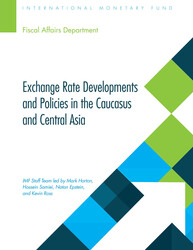
Exchange Rate Developments and Policies in the Caucasus and Central Asia
Exchange Rate Developments and Policies in the Caucasus and Central Asia
READ MORE...
Volume/Issue:
Volume 2016
Issue 007
Publication date: May 2016
ISBN: 9781513543031
$20.00
Add to Cart by clicking price of the language and format you'd like to purchase
Available Languages and Formats
| English |
Prices in red indicate formats that are not yet available but are forthcoming.
Topics covered in this book
This title contains information about the following subjects.
Click on a subject if you would like to see other titles with the same subjects.
Banks and Banking , Money and Monetary Policy , Public Finance , DPPP , DP , government , country , central bank , High ER , CCA country , ER flexibility , ER Policy framework , ER regime , ER policy , CCA central banks , central bank communications , Communications in revenue administration , Currencies , Dollarization , Monetary policy frameworks , Global
Summary
Since late 2014, exchange rates (ERs) and ER regimes of the Caucasus and Central Asia (CCA) countries have come under strong pressure. This reflects the decline of oil and other commodity prices, weaker growth in Russia and China, depreciation of the Russian ruble, and appreciation of the U.S. dollar, to which CCA currencies have historically been linked. Weaker fiscal and current account balances and increased dollarization have complicated the picture. CCA countries entered this period with closely managed ER regimes and, in many cases, currencies assessed by IMF staff to be overvalued. CCA central banks have price stability as their main policy objective, and most have relied on ER stability to achieve this objective. Thus, the first policy response involved intervention in local foreign exchange (FX) markets, often with limited communication. In this context, the IMF staff has reviewed ER policy advice and implementation strategies for CCA countries.
Copyright © 2010 - 2026
Powered by:
AIDC



